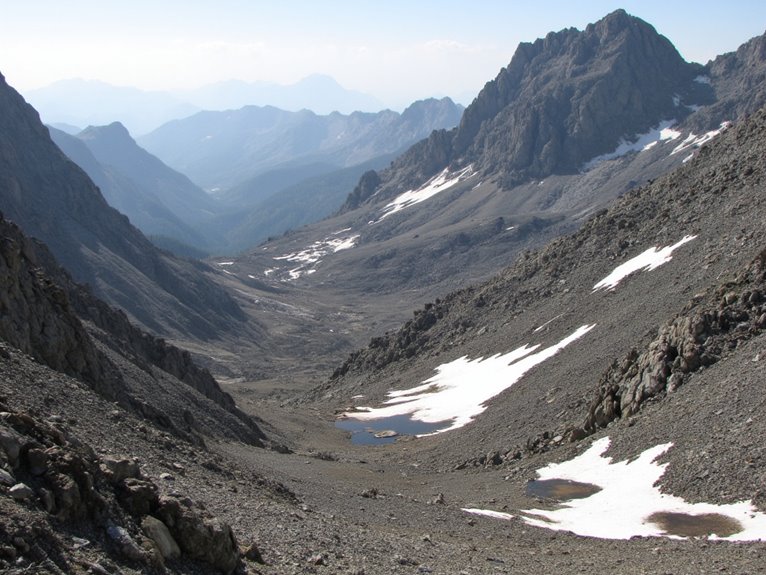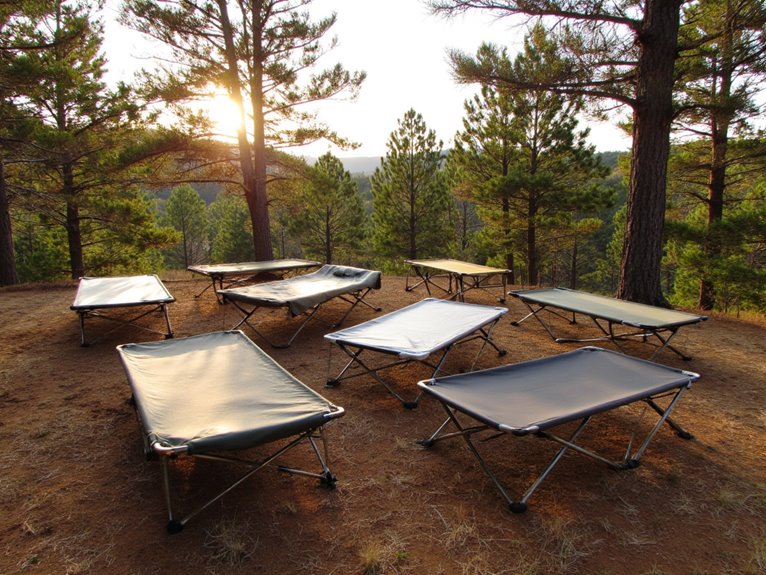Climate Change Impact on Alpine Hiking Routes
Climate change directly threatens your alpine hiking experience through multiple cascading effects. You’ll encounter 40% more extreme weather events creating flash flood conditions, while European Alps glaciers have shrunk 39% in two decades, exposing unstable rock slopes with increased rockfall activity. Rising temperatures extend hiking seasons but destabilize permafrost-dependent mountain huts and infrastructure designed for -20°F to 100°F ranges. Extended access periods increase foot traffic on fragile alpine vegetation during previously protected winter months, causing threefold soil compaction increases and trail widening as snowpack duration decreases 2-4 weeks annually. Understanding these extensive impacts reveals essential adaptation strategies for safe mountain exploration.
We are supported by our audience. When you purchase through links on our site, we may earn an affiliate commission, at no extra cost for you. Learn more. Last update on 26th November 2025 / Images from Amazon Product Advertising API.
Notable Insights
- Extreme weather events occur 40% more frequently, creating flash floods that wash out trails and increase rockfall hazards.
- European Alps glaciers have shrunk 39% in two decades, exposing unstable rock slopes and increasing rockfall activity.
- Thawing permafrost destabilizes mountain hut foundations and reduces ice cohesion, creating additional hazards for alpine hikers.
- Reduced snowpack duration by 2-4 weeks annually increases foot traffic on fragile alpine vegetation during vulnerable periods.
- Heatwaves exceeding 95°F at elevation significantly elevate dehydration risks and require climate-resilient trail infrastructure adaptations.
Extreme Weather Events and Trail Safety Challenges
As extreme weather events intensify across alpine regions, traditional hiking routes face unprecedented safety challenges that demand immediate attention from trail managers and outdoor enthusiasts alike.
Heavy rainfall events now occur 40% more frequently, creating flash flood conditions that can wash out trail sections within minutes. You’ll need thorough flash flood preparedness protocols including escape route identification and waterproof emergency gear.
Flash floods can devastate trail sections in minutes, making escape route planning and waterproof emergency equipment absolutely essential for alpine hikers.
Storm-related tree falls block pathways while destabilizing loose rocks on exposed ridgelines. Heatwaves exceeding 95°F at elevation increase dehydration risks considerably.
Extreme weather forecasting systems now provide hourly updates, but conditions change rapidly above treeline. Trail infrastructure requires climate-resilient materials rated for temperature fluctuations between -20°F and 100°F.
Emergency evacuation routes face frequent disruption from debris flows. Multi-day alpine expeditions require gear rated for these temperature extremes, with ultralight sleeping bags designed for conditions 10-15°F below expected temperatures becoming essential safety equipment.
Glacier Retreat and Rock Slope Instability
While extreme weather creates immediate trail hazards, glacier retreat presents a more insidious threat that’s reshaping alpine hiking routes across mountain ranges worldwide.
European Alps glaciers have shrunk 39% over two decades, exposing previously ice-supported rock slopes. When you’re hiking near retreating glaciers, you’ll encounter increased rockfall activity and unstable terrain.
Glacier mass loss destabilizes surrounding rock formations through multiple mechanisms. Aletsch Glacier has retreated over 1,300 meters since 1984, while Swiss glaciers lost 2.5% of their volume in 2024 alone.
This retreat removes natural support from rock faces, triggering enhanced rock failure events. Warming permafrost compounds these hazards by reducing ice cohesion that acts as natural cement within rock masses.
You’ll find trails near glaciers like Montenvers-Mer-de-Glace requiring frequent route adaptations due to ongoing slope instability and increased debris flows.
Extended Hiking Seasons and Increased Visitor Pressure
Although glacier retreat creates dramatic geological changes, climate change‘s impact on hiking accessibility follows a more gradual pattern that’s fundamentally altering mountain recreation.
You’re now experiencing extended seasons as warmer temperatures reduce snowpack duration by 2-4 weeks annually. Spring access begins earlier while autumn conditions persist longer, creating year-round trail pressure.
This accessibility shift directly affects hiker behavior patterns. You’ll encounter increased foot traffic on fragile alpine vegetation during traditionally protected winter months.
Trail widening accelerates from 15% more annual visitors. Soil compaction increases threefold during extended seasons.
The ecosystem balance faces unprecedented stress. Alpine plants experience prolonged trampling exposure beyond their evolutionary adaptation periods.
You’re witnessing trail degradation requiring intensive maintenance interventions. Infrastructure demands climate-resilient materials as visitor pressure combines with extreme weather events, fundamentally challenging traditional mountain recreation models.
Infrastructure Vulnerabilities and Mountain Hut Closures
Beyond surface-level trail wear, climate change threatens the structural foundations that enable alpine recreation entirely.
Mountain hut vulnerabilities stem from thawing permafrost and unstable terrain that compromise building foundations. You’ll encounter increased closures as authorities prioritize visitor safety challenges over recreational access.
Retreating glaciers create three critical infrastructure problems:
- Extended access distances – Routes to huts become longer and more complex
- Unstable ground exposure – Previously glacier-covered terrain reveals hazardous slopes
- Foundation destabilization – Shifting permafrost damages hut structural integrity
Rockfall incidents force temporary or permanent closures of popular destinations.
Some regions now require rescue service deposits, reflecting heightened operational risks. Trail diversions become necessary as traditional routes cross unstable sections.
Digital mapping tools help managers identify vulnerable areas before catastrophic failures occur, enabling proactive infrastructure protection.
Alpine Vegetation and Soil Erosion Impacts
As temperatures rise across alpine regions, the delicate balance between vegetation communities and soil stability faces unprecedented disruption that directly affects hiking trail conditions.
You’ll encounter dramatic vegetation shifts as alpine flora communities change their species composition by 21–70% by 2079. These changes create unstable trail surfaces when root systems that once anchored soil disappear.
Soil erosion intensifies markedly across hiking areas. Rainfall erosivity in NSW alpine regions will increase 8–18% by 2079, creating washouts and trail damage.
You’ll notice that Alpine Cryosols above 2,400 meters become particularly unstable as permafrost retreats upward. The loss of frost-stabilized ground means increased rockfall and trail collapse risks.
Different bedrock types respond variably. Siliceous bedrock areas show decreased vegetation cover but increased litter, affecting your footing and trail visibility during hikes.
Seasonal Access Changes and Route Availability
You’ll face markedly altered timing for alpine access as climate change reshapes traditional hiking seasons.
Warming temperatures are extending overall trail availability into shoulder months, but you’re also encountering shortened peak summer windows due to increased rockfall risks and unstable conditions from glacier retreat.
Earlier snowmelt means you can access high-elevation routes weeks sooner than historical norms, yet these same trails may close unexpectedly in late summer when rising temperatures destabilize formerly reliable mountain terrain.
Shortened Summer Seasons
When alpine hiking seasons that traditionally extended from June through September now compress into narrower windows, you’re witnessing one of climate change‘s most immediate impacts on mountain recreation.
Glacial retreat and unstable terrain force authorities to restrict routes during peak summer months. You’ll find mountain huts closing unexpectedly and familiar trails rerouted due to rockfall activity.
Three major factors shorten your hiking opportunities:
- Increased rockfall frequency during warmer mid-summer periods
- Earlier snowmelt destabilizing traditional route foundations
- Extended hazard periods replacing historically safe hiking windows
Trail conservation efforts now require climate-resistant materials and adaptive management strategies.
Your hiking gear must accommodate unpredictable conditions as routes become unnavigable when temperatures peak.
This paradox means longer warm periods don’t guarantee extended access.
Earlier Access Requirements
Beyond the shorter hiking windows, planning your alpine adventures now demands securing permits months earlier than before.
Parks like Zion open lottery systems in January for spring hikes, while Rocky Mountain National Park requires timed-entry reservations starting May 23rd. You’ll need to navigate Recreation.gov’s centralized platform, where permits release simultaneously early each calendar year.
These access regulations extend beyond simple scheduling. Rocky Mountain’s Bear Lake Corridor permits restrict entry to 5 a.m.-6 p.m. windows, while other areas limit access from 9 a.m.-2 p.m. Popular destinations like The Wave now operate under monthly lottery systems that open on the first of each month, limiting daily access to just 64 visitors. Grand Canyon’s backcountry permits become available through a four-month advance lottery system that requires hikers to plan overnight rim-to-rim adventures well before traditional season planning.
Construction closures compound these challenges—Glacier’s Going-to-the-Sun Road blocks day hikers from July through September 2025. Your permit planning must now account for climate-driven route modifications, infrastructure projects, and safety concerns that reshape traditional hiking seasons into strictly regulated timeframes with narrow entry windows.
Climate-Resilient Trail Management Strategies
You’ll find that effective trail management now depends heavily on digital monitoring technologies that track real-time hazards like rockfall zones and unstable slopes.
These systems use sensors and satellite data to provide early warnings, while open-source digital platforms allow trail managers to share critical safety information across entire alpine regions.
Cross-border collaboration frameworks enable you to access harmonized trail networks where multiple countries coordinate their climate adaptation strategies, pooling resources and expertise to maintain safer hiking routes.
Digital Monitoring Technologies
Since traditional trail management methods can’t keep pace with rapidly changing alpine conditions, digital monitoring technologies have become essential tools for maintaining safe and sustainable hiking routes.
Digital communication systems now enable real-time data collection across remote terrain. You’ll find digital kiosks along major Alpine routes providing Wi-Fi access and current trail conditions.
Modern monitoring systems integrate three key components:
- GIS platforms that analyze 930,000+ property datasets across 13-county regions
- Citizen science apps like GLOBE Observer for environmental data collection
- Automated registration systems linking state databases with trail management platforms
These technologies enhance hiker engagement through voluntary registration systems like ATCamp.
GPS-enabled navigation apps have fundamentally changed how you plan routes. Crowdsourced observations help identify vulnerable trail segments prone to climate-related damage, supporting adaptive management decisions.
Just as alpine hikers require water filtration systems that can handle varying micron-sized contaminants in backcountry sources, digital monitoring networks must filter and process diverse environmental data streams to ensure accurate trail condition assessments.
Cross-Border Collaboration Frameworks
While digital monitoring provides real-time data within individual countries, alpine hiking routes don’t respect political boundaries—and neither should their management systems. Cross border governance frameworks create joint committees that coordinate trail management across national boundaries.
You’ll find these systems particularly effective for managing ecological connectivity between protected areas.
Joint governance structures establish memoranda of understanding for avalanche forecasting, habitat protection, and climate adaptation measures. These frameworks integrate spatial planning processes that prioritize trail resilience to increased erosion and weather variability.
Cross-border cooperation networks include public authorities, NGOs, and regional planners who coordinate visitor flows and resource preservation.
Unified masterplans like GREMA and SUSPLAN enhance hiking infrastructure resilience while harmonizing transport access and conservation strategies across borders.
Economic and Tourism Implications for Mountain Communities
Climate change dramatically reshapes the economic foundation of mountain communities that depend on alpine hiking tourism for their survival. Extended seasons increase visitor numbers but create infrastructure strain requiring costly adaptations.
Trail damage from extreme weather events forces expensive rerouting and reconstruction projects.
Communities must implement strategic responses through:
Mountain communities require deliberate strategic interventions to navigate climate-driven tourism challenges while preserving both economic stability and environmental integrity.
- Economic diversification beyond tourism dependency
- Sustainable practices for trail maintenance and resource management
- Visitor education programs addressing environmental stewardship
Local engagement drives community initiatives that balance tourism revenue with ecosystem preservation. Investment in climate-resilient infrastructure creates jobs but demands significant funding.
Destabilized landscapes and glacier retreat threaten scenic appeal, potentially reducing long-term visitor interest. Successful adaptation requires thorough planning that integrates environmental stewardship with economic viability for sustainable mountain tourism futures.
Frequently Asked Questions
How Can Hikers Prepare Equipment for Unpredictable Alpine Weather Conditions?
You’ll need weather resistant clothing with moisture-wicking base layers, insulating mid-layers, and waterproof outer shells.
Pack portable weather tools like a barometric altimeter and wind meter to monitor changing conditions.
Bring crampons or microspikes for icy terrain, plus gaiters to protect boots.
Carry extra gloves, hats, and face protection.
Include emergency gear like thermal blankets and hand warmers for unexpected temperature drops.
What Insurance Considerations Exist for Increased Rescue Costs in Changing Mountains?
You’ll need specialized rescue insurance covering evacuations up to $100,000 minimum, as remote mountain rescues exceed $40,000 per incident.
Standard travel insurance excludes high-altitude activities above 5,000 meters. Verify your policy includes helicopter evacuation and matches your planned elevation limits.
Consider liability coverage for search-and-rescue team expenses. Multi-layered insurance combining rescue specialists like Global Rescue with medical coverage guarantees all-encompassing protection against escalating mountain rescue costs.
How Do Authorities Decide When to Permanently Close Dangerous Routes?
Authorities use thorough trail assessment protocols when you’re dealing with route closure decisions.
They’ll evaluate accident frequency, fatality rates, and structural damage from weather events.
Safety protocols require specialized crews to inspect trails after storms, measuring erosion rates and rockfall risks.
You’ll see closures when mitigation isn’t feasible – authorities weigh repair costs against user safety, consulting environmental scientists and analyzing meteorological data patterns.
Which Specific Gear Modifications Are Recommended for Altered Seasonal Conditions?
You’ll need specific gear adaptations for today’s unpredictable alpine conditions.
Choose lightweight synthetic mid-layers over down, which fails when wet.
Seasonal adjustments include quick-drying boots with integrated gaiters and microspike crampons for mixed terrain.
Pack ultralight rain gear with pit zips, waterproof pack covers, and emergency bivies.
Add GPS devices with real-time weather updates and carbide-tipped poles for unstable trails.
What Legal Liability Issues Arise From Climate-Related Trail Accidents?
You face increased legal exposure when climate-related accidents occur on trails under your management.
Courts now expect updated risk assessments reflecting changing conditions like rockfall and permafrost instability.
Your liability waivers must explicitly address climate-induced hazards to remain legally robust.
Inadequate trail maintenance or failure to warn hikers about evolving dangers can result in negligence claims, even when causation proves difficult to establish definitively.
On a final note
You’re witnessing fundamental changes to alpine environments that’ll reshape how you experience mountain hiking. Rising temperatures increase rockfall risk by 15-20% annually while extending seasons from traditional 4-month windows to 6-7 months. You’ll need updated gear, flexible planning, and enhanced safety protocols. Trail closures will become routine as infrastructure adapts. Your hiking strategies must evolve with these rapidly changing conditions to maintain safety margins in increasingly unpredictable alpine terrain.



